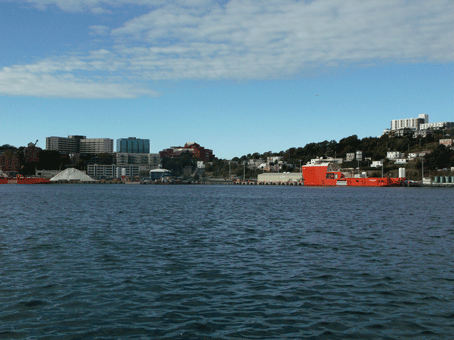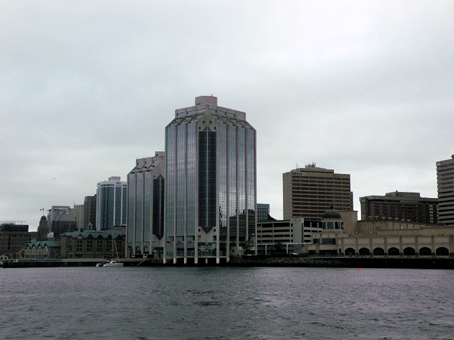The Duck is an amphibious vehicle originally built for the military during the Vietnam War. Now they are used for city and harbour tours in both Halifax and Sydney, Nova Scotia, as well as a number of other coastal cities in North America.
The tour took us through the downtown area of Halifax, then out into the harbour for a view from the other side.

Halifax is a somewhat more modern city than St. John's and while the harbour is much bigger, it's not quite as picturesque.
The harbour is large and consists of many bays and small coves. It was formed when a glacial valley succumbed to the sea level rise which occurred when the glaciers melted. .The city itself is a mixture of both historical and modern buildings.

On our way into port, we passed one of six lighthouses in and around Halifax.

In the distance is the Town Clock, also known as the Old Town Clock or Citadel Clock Tower, and is one of the most recognizable landmarks in Halifax. The Clock was erected on the east slope of Citadel Hill and was commissioned by Prince Edward, Duke of Kent, in 1800 in order to put an end to the local garrison's "tardiness".

After The Duck picked us up at the harbour, it took us on a short tour of the main downtown area. We didn't take many pictures as the area was similar to that of any major city.
We did pass some historic buildings, like this one. The area was once home base for the privateers and there was subsequent demand for more storage space, shops, and services. Between 1800 and 1875, a collection of seven warehouse style buildings were built and became known as the Historic Properties or Privateers Wharf..

And of course every city has one of these.

The harbour is home to many pleasure boats as well as tour boats, as seen here.

The view inside The Duck as it headed down the ramp and into the harbour.

I tried to find out what wharf this was but couldn't. Anyway it's an oldie, complete with observation area at the end of the pier and a beacon on top to help guild the ships.

The two modern buildings are known as Purdy's Wharf. It is an office complex consisting of the 2 buildings plus a seven story parkade and walkways connecting the complex to Casino Nova Scotia and the Downtown Halifax Link system.

Halifax has almost 4 km/2.5 miles of boardwalk, complete with views of the harbour and seawall, as well as waterfront cafes, shops, and museums. These restaurants and shops are located near the Historic Properties of Privateers Wharf.

Halifax maintains a delicate balancing act between modernization and preserving it's rich heritage.

Georges Island (named after King George II of England is the largest island entirely within the limits of Halifax harbour. The Island is the location of Fort Charlotte, named after King George's wife, and was built during Father Le Loutre's War (1749–1755), also known as the Indian War. The island is now a National Historic Site but is not open to the public except for special events. In addition to the ruins of Fort Charlotte, the island also contains the Georges Island Lighthouse and its keeper's dwelling.

And finally, a Royal Canadian Navy (RCN) frigate from its Atlantic fleet, Maritime Forces Atlantic (MARLANT).
I guess all the parking spaces were full at the nearby base.